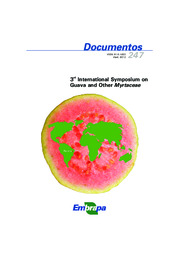Up scaling guava water balance in the Petrolina-Juazeiro growing area, Northeast Brazil.
Up scaling guava water balance in the Petrolina-Juazeiro growing area, Northeast Brazil.
Autoria: TEIXEIRA, A. H. de C.; HERNANDEZ. F. B. T.
Resumo: The modeling of crop water variables at large scales is important when aiming a sustainable development, while insuring water availability for different users. Weather data for 2011, from a net of 15 automatic agro-meteorological stations and field energy balance results from previous experiments, were used together with regression models to quantify the guava water requirement (GWR) in the growing area of Petrolina (Pernambuco state)-Juazeiro (Bahia state), Brazil, considering a 6.5 months average growing season (GS). GWRGS joined with precipitation, allowed the acquirement of the regional water balance by developing and applying a guava water indicator (GWIGS) being the ratio of the total precipitation during a growing season (PGS) to GWRGS. The analyses made possible the characterization of areas with different natural humidity conditions for guava production, comprising two pruning periods. The variation of the averaged GWRGS values for the Petrolina municipality was from 750 ± 6.9 mm to 950 ± 10.5 mm, for pruning in January and June, respectively, the wetter and dryer GS, while for the Juazeiro municipal district the respective ranges were from 730 ± 6.2 mm to 900 ± 9.2 mm. Considering the GWIGS indicator, the values for both municipalities were similar, around 0.40 and 0.08 for pruning in January and June, respectively. Quantifying the differences between PGS and GWRGS, the need of irrigation could also be quantified, being evident the highest water amounts to be applied when the prunes are done in June, with the argest rates between September and October, from 160 to 174 mm month-1. Additional data from IBGE (Brazilian Geographical and Statistical Institute) allowed the inspection of the guava water productivity (GWP) at the municipal level. The GWP values for Petrolina were 4.1 and 3.3 kg m-3, while for Juazeiro they were 1.8 and 1.5 kg m-3, for pruning in January and June, respectively. The higher GWP values for pruning in January are explained by the coupled effect of higher PGS and lower GWRGS rates. On the other hand, as the both municipalities had similar GWIGS ranges, it could be concluded that the lower GWP values for Juazeiro should be a poorer crop management, resulting in lower yield, evidencing ample room for water productivity improvements. The analyses spatially presented, can subsidize water allocation and irrigation management criteria, when aiming improvements on guava water productivity and yet, avoiding environmental damage by fast climate and land use changes in the Brazilian semi-arid areas.
Ano de publicação: 2012
Tipo de publicação: Resumo em anais e proceedings
Unidade: Embrapa Semiárido
Palavras-chave: Balanço Hídrico, Coeficiente de cultura, Goiaba, Guava, Modelagem, Necessidade de água, Produtividade, Produtividade da água, Recurso Hídrico, Água
Observações
1 - Por padrão são exibidas publicações dos últimos 20 anos. Para encontrar publicações mais antigas, configure o filtro ano de publicação, colocando o ano a partir do qual você deseja encontrar publicações. O filtro está na coluna da esquerda na busca acima.
2 - Para ler algumas publicações da Embrapa (apenas as que estão em formato ePub), é necessário ter, no celular ou computador, um desses softwares gratuitos. Sistemas Android: Google Play Livros; IOS: iBooks; Windows e Linux: software Calibre.
Acesse outras publicações
Acesse a Base de Dados da Pesquisa Agropecuária (BDPA) para consultar o acervo completo das bibliotecas da Embrapa.

